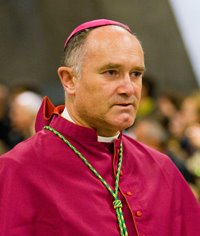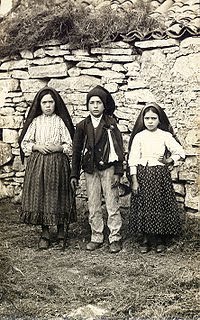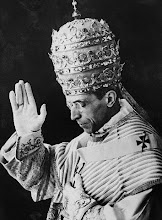(Introduction) The Reform and the Law of Faith[12]
Attenuation of the three principal dogmas concerning the Mass in the Novus Ordo
In order to judge the dogmatic, moral, and spiritual worth of this reform, we must briefly recall the immutable principles of the Catholic Faith concerning the essence of our holy Mass. These propositions are “de fide divina catholica definita” — defined truths of Divine and Catholic faith. They are therefore dogmas, such that someone who did not believe them would by that very fact be outside the Church. The first truth is that “in the Mass a true and real sacrifice is offered to God.”[13] We must add that this sacrifice is a propitiatory sacrifice, a point that will be of use when we look at the New Mass.[14] The second is the dogma “The host or the victim is Christ Himself present under the species of bread and wine.”[15]The third affirmation is that “The priests, and they alone, are the minsters.”[16]It is obvious that these three fundamental truths are — not to be severe in our judgment of the Novus Ordo — at least clearly weakened, and this we can easily prove whether by internal or external factors, that is to say, by an analysis of the Ordo itself; also, by what outsiders say about it; and, lastly, by the realities that flow from this reform. But it is especially by the internal proofs, that is to say, by studying the Novus Ordo itself, that we reach this conclusion.
Archbishop Lefebvre now illustrates in detail the depreciation of these three dogmas in the Novus Ordo. [The first one, "The New Mass and the Sacrifice" is presented here — the other two will be provided in the coming weeks.]
(First principal dogma) The New Mass and the Sacrifice
The Novus Ordo weakens the notion of sacrifice. The suppression of certain prayers and liturgical gestures hides the sacrificial aspect of the Mass. The churches themselves are no longer centered on the altar.1. The absence of sacrifice in the liturgy
Basically, there are two parts in the Novus Ordo: the Liturgy of the Word and the Liturgy of the Eucharist. The liturgy of the sacrifice is gone. That is why immediately after the quick words of the Consecration the distribution of the Eucharistic bread takes place.It constitutes a diminution of what is the center of the Mass, of what the sacrifice of the Mass truly is.
2. Suppression of the propitiatory prayers
All the texts that very clearly affirm the propitiatory end, the essential end, of the sacrifice of the Mass have been removed. One or two faint allusions still remain, but that is all. This was done because the propitiatory end is denied by the Protestants.The prayers that explicitly expressed the idea of propitiation, like those of the Offertory and those pronounced by the priest before communicating, have been suppressed. Likewise, at the end of the Mass, the prayer to the Blessed Trinity, which says “...grant that the sacrifice which I...have offered up in the sight of Thy Majesty may be acceptable to Thee, and through Thy mercy be a propitiation (propitiabile — the very word is used!) — for me and for all those for whom it has been offered,” has also been suppressed. The expression “sacrifice” is absent from Canon II, attributed to St. Hippolytus.[21] The diminution of the notion of sacrifice in the new rite is obvious because the term sacrifice itself is rarely employed; and when it is employed, it is in a Protestant manner, because the Protestants accept the term sacrifice for the Mass but only in the sense of a sacrifice of praise or Eucharistic sacrifice, but certainly not in the sense of a propitiatory sacrifice.
3. A suppression inspired by Protestantism
When you say, “The notion of sacrifice is being lost in the Novus Ordo,” the innovators respond, “No, look, the word sacrifice is still here and there.” Indeed, the word sacrifice is used a few times.... The Protestants also accept the notion of sacrifice in the Mass, but uniquely as a sacrifice of thanksgiving, praise, or adoration, and not as a propitiatory sacrifice, which is essential to the Catholic notion of sacrifice. The Council of Trent wrote entire chapters about this against the Protestants. Thus it is a very serious matter to have suppressed all the prayers speaking of propitiatory sacrifice.The result, unfortunately, of the post-conciliar reforms has been to affect the notion of sacrifice, the notion of the Passion continued in the sacrifice of the Mass. Not that the innovators have denied it outright, but that they do not mention it, with the result that men forget it; they no longer think of it. Certainly, the authors of the new, post-conciliar liturgy have not denied the sacrifice of the Mass, but by the fact that they put so much emphasis on the table, the Eucharistic meal, and by omitting the term sacrifice, or at least by speaking of it only occasionally so that they can claim that they are not unaware of it, people stop believing in the virtue of Calvary.
I could have brought you a book that came out during vacation entitled Fifteen Bishops Profess the Faith of the Catholic Church, published by the Cerf Publishing house. Three of the fifteen bishops are cardinals. The worst of the articles is surely the one by the bishop of Arras on the Mass. In the book he writes: “It is said that the sacrifice of the Mass was made to offer satisfaction — that horrible word, satisfaction.” He asserts that this term originated in a medieval idea that represents God the Father as needing blood for the remission of our sins, as if God were a blood-thirsty executioner who wants to immolate His Son and who wants His Son’s Blood. Yet the Council of Trent clearly affirms that Our Lord offered His life as a propitiation for our sins, hence for satisfaction, which is another term that means the same thing. This approach to understanding Christ’s sacrifice is found in St. Paul. If the notion of propitiatory sacrifice is excluded, then there is nothing left to do but cast all St. Paul’s epistles into the fire. Consequently, what do these bishops understand of the sacrifice of the Mass?
4. Suppression of the gestures symbolizing the sacrifice
Moreover, to analyze the new rite, I think that it is necessary to consider not only the texts, but also all the rubrics and the new gestures that are required: the genuflections, the Signs of the Cross, the inclinations...and even the change in the objects. Thus, in the first Canon, all the Signs of the Cross have been suppressed! One day I was celebrating Mass, at the Swiss Carmel, I think. The Carmelites didn’t have a new missal. They had an old missal that had been given to them. But the missal had been scrawled all over by the reformers. There was a big red circle over every cross to show that it had been deleted. Likewise, the rubrics mentioning genuflections were crossed through in red. I could see at a single glance the complete transformation of the Canon! I assure you, the first Canon is no longer the Roman Canon. That clearly is not so; everything was changed: no more genuflections, no more Signs of the Cross! Appalling! The Sign of the Cross showed that it indeed concerned the sacrifice of the Cross. Let us not say that these are merely details. These are not details; these are gestures that have meaning and value.Another example: The grandeur of the sacrifice requires that the altar be made of a noble material and in some way be attached to the ground. From the fourth century, the Church has prescribed the altar stone. Undoubtedly altar stones were already in use, but the pope who prescribed the altar stone for offering the sacrifice only confirmed what probably had been done from the beginning. Well, the altar stone was suppressed. It is no longer obligatory, and now the altar is replaced by a simple table to signify better the meal rather than the sacrifice; and that certainly does not enhance the dignity or sacred character of the Mass, which is a true sacrifice.
The suppression of the altar stone also led to the suppression of the relics of the holy martyrs who were immolated and who shed their blood for Our Lord Jesus Christ, and thus the union of the blood of the martyrs and the Blood of Our Lord expressed by the presence of the saints’ relics in the altar stone. The beautiful link that exists between the sacrifice of the saints and the sacrifice of Our Lord who offers Himself on the altar is no longer represented. How could they have suppressed these things? It is unbelievable!
I told Cardinal Seper: “See how the notion of sacrifice is diminished.” The Church has always had the sense of sacrifice. I would even say that it is in the nature of man. It is a part of man’s nature to offer sacrifices. All sacrifices are offered on a stone, on something solid. And they suppressed the altar stones!
The doing away with the altar stone, the introduction of a table covered with a single cloth, the turning of the priest towards the people, the host left on the paten and not on the corporal, the authorization of the use of ordinary bread, vessels made from diverse materials, even the humblest — all these and many other details help to inculcate those present with Protestant notions essentially and gravely opposed to Catholic teaching.
5. The altar cross suppressed or relegated to the side
The crucifixes on the altars have also often been suppressed, or at least moved to the side of the altar. Consequently, there is not even a reminder of the Passion of Our Lord Jesus Christ for something that is the true, real reproduction of Our Lord’s sacrifice.Occasionally finding myself in Spain, I recently went to the mountains to visit the little villages. The first thing I did was to go to the church to see if perhaps in these remote regions of Spain there was still an altar of sacrifice as before. But no, there was nothing. There was no crucifix! But where is the sacrifice? They’ve suppressed the cross! I looked for the cross, but there was no cross. There was just a bare, meaningless table. That is not the Catholic Faith. The Catholic Faith is the sacrifice of Our Lord Jesus Christ in which we participate and which transforms Christian life — the life of families and societies.
The suppression or displacement of the altar cross betokens a diminution of the idea of sacrifice. The Church requires a crucifix on the altar; it must be there precisely because it reminds us of the sacrifice of Calvary.
The innovators no longer see in the Mass a propitiatory sacrifice, but we must always come back to that. We must always put the faithful at the foot of the Cross, before the sacrifice of Our Lord. This must be our recurrent theme. The Mass is a sacrifice. A sacrificial action is effected, and we partake of the Victim. It is not a “sharing of bread”; it is not a “sharing of the word.”
People want nothing to do with the Cross of Our Lord Jesus Christ. They want nothing to do with His sacrifice, because His sacrifice reminds us that we must sacrifice ourselves, that to have life we must die to our sins, and men who seek their pleasures and satisfactions cannot stand to see it, hear it, or understand it. They want no part of the Cross. That is why so many crucifixes have disappeared in our day.
6. The Mass celebrated facing the people in the Roman basilicas
The priest turns towards the crucifix for the offering of the sacrifice. Thus the Mass celebrated facing the people takes away this notion of sacrifice. Some argue that at Rome the altars on which the pope celebrates are altars facing the people.[38] That is true, and yet it is not true, because the pope celebrates with his entire chapter, which is behind him. Thus, when the pope would celebrate, he did not turn towards the notables present — all the priests, and cardinals, and his entire court. He turned towards the faithful, but he was at such a distance that his face could scarcely be seen. On all these altars there was a crucifix, candelabra, and other ornamentation that created a separation. And then, he celebrated facing Our Lord Jesus Christ. It was not in order to celebrate Mass facing the people that he was turned towards the people, but it was because of the orientation of the basilica.[39]7. The sacrifice of the Mass is no longer visibly signified in the churches
In the beautiful basilicas that our ancestors built, one can see that the altar is truly the heart of the edifice. You have the building’s main nave and the transept representing the Cross of Our Lord, and the altar is in the place of Our Lord’s heart. Having lost the notion of sacrifice in the Mass, the innovators now create any kind of building for a church. They construct some kind of hall, and a multi-purpose hall at that, suitable for all kinds of events, and there they “do the Eucharist,” as they call it. A table can be put anywhere. It isn’t necessary to have a building that represents the Cross. It has no meaning at all.Contrariwise, in the olden days those who built the churches really intended to reproduce the Cross. For them, the sacrifice of the Mass was truly the sacrifice of Our Lord and not only, like now, a “Eucharist.”
8. From the disappearance of the Sacrifice to the disappearance of the Sacrament
There are two great realities in the Mass, which are the sacrifice and the Sacrament. These two great realities are realized at the same instant, at the moment when the priest pronounces the words of the consecration of the bread and the wine. When he has finished the words of consecration of the precious Blood, the sacrifice of Our Lord is accomplished, and Our Lord is also there present; the Sacrament of Our Lord is there, too....This mystical separation of the species of bread and wine realizes the sacrifice of the Mass. Thus, these two realities are effected by the words of consecration. They cannot be separated. But that is what the Protestants did; they wanted only the Sacrament with the sacrifice. They have neither the one nor the other, neither the Sacrament nor the sacrifice. And that is the danger of the New Masses. They no longer speak of sacrifice; it seems that they ignore the sacrifice. Now they only speak of the Eucharist, they do a “Eucharist” as if it were only a meal. There is a real risk of their having neither the one nor the other. It is very dangerous. Inasmuch as the sacrifice disappears, the Sacrament also disappears because what is present in the Sacrament is the victim. If there is no more sacrifice, there is no victim.9. An official document from the Paris chancery
Here is a document from the Centre Jean-Bart, official center of the Archbishopric of Paris; there are incredible statements, for instance Christ’s Eucharist Today (no out-of-date publication, it is dated March 17, 1973): “Is not the Mass Our Lord’s Supper, an invitation to communion?” There is no more mention of sacrifice. Then: “At the heart of the Mass lies a story”....No, it is not a story.What we are celebrating then is a memorial of our redemption. Memorial, a word which it is essential to understand. It is not a question of commemorating a past event, as though meeting simply in remembrance. Neither is it a question of the renewal of that event. Christ died and rose again once for ever — that can never happen again.“Can never happen again”? Is not Our Lord able to perform a miracle and repeat for us His sacrifice on Calvary?
Those who hold authority in the Church are gradually making the notion of propitiatory sacrifice disappear, and exalt communion even more than the Real Presence.




























